New regulations on the sale of herbal medicines come into force at the beginning of April. Our Crop to Cure event on 29 March is therefore an ideal opportunity to bring yourself up to date with what the new regulations will mean for all involved in the growing and production of herbal medicines. Speakers will be examining not just the legislation but also the whole area of research into isolating plant-derived medicines, extraction, processing, formulation and marketing. Make sure to book your place: Medicinal Plants: From Crop to Cure? on 29 March.
And do not forget our other forthcoming event, Biofortified and Functional Food: A Healthy Future? on 19 May.
Editor
Developments in Biocontrol
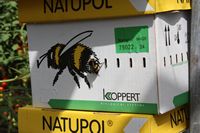
Tony Girard, UK Director of Koppert BV, opened the meeting by describing the history of the company. Founded in 1967 to supply Phytoseiulus persimilis to Dutch growers for the control of red spider mite, Tetranychus urticae, the company expanded to supply other biological agents for pest and disease control. They have been exporting these to growers in the UK and other European countries since 1977. In 1988 they joined the developing market to supply bumble bees for the pollination of tomatoes. Over the years the company has expanded its range of products and now has 18 subsidiaries, supplying 80 countries worldwide. (photo: Peter Grimbly: Beehives in a tomato crop)
This expansion has necessitated a high level of logistic and quality control procedures to ensure that the living material is in good condition when it leaves the breeding centres and remains so during transport and on arrival at the growers holding. Added to this is full traceability so that if something does go wrong the cause can be rapidly identified and corrected.
Talks followed by Product Development Manager, Karen Girard, and Technical Consultant, Jasper Hubert, who described some of the now traditional agents for biocontrol as well as the latest developments.
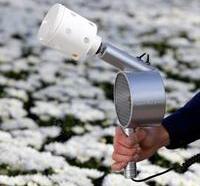
Once a good balance of pest and predator or parasite is achieved, all should be well. Unfortunately, as Augustus de Morgan observed ‘Great fleas have little fleas upon their backs to bite 'em, and little fleas have lesser fleas, and so ad infinitum'. In the last few years this has come true with the appearance of significant levels (up to 80%) of hyperparasitism; hyperparasites that attack the beneficial insects introduced to control a pest species. Since, at present there are no controls available for hyperparasites a second species of insect, unaffected by the hyperparasite, is needed to take over control of the pest. Thus if the initial control of aphids was achieved using Aphidius which has subsequently succumbed to hyperparasitism then other beneficials like Aphidioletes, lacewing larvae, hoverflies, and Aphelinus can be introduced.
Much work has been done to assess the benefits of using the fungus, Trichoderma harzianum, to improve the root environment by reducing pathogenic fungi and enhancing nutrient uptake. This has now been taken a step further with the experimental introduction of NatuGro. This system involves the initial introduction to the growing medium of a balanced mixture of soil micro-organisms followed by monitoring of the soil microflora. Based on the proportion of different microflora found in the growing media supplements are added to ‘rebalance' the substrate. Growing media such as rockwool tend to have a predominantly bacterial microflora while others like coco-peat have high levels of soil fungi. The object of the Natugro system is to create a ‘balanced' microflora in all media. Its use is still in its early stages but has been introduced on the understanding that it can do no harm to the crop but may well be of benefit.
Plant of the Month
Colocasia esculenta (taro, Araceae)
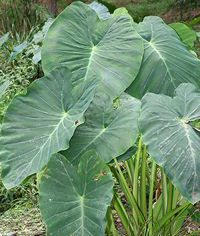
On a recent visit to Hawaii (Oahu, Kauai and Maui) I saw first-hand the vast paddy fields of taro growing as well as the traditional terraces (lo'i) in Limahuli garden (part of the National Tropical Botanic Garden). In Hawaii taro is known as kalo and it is believed that the taro plant was the ancestor of all Hawaiian peoples. Kalo root (corm) is cooked and then pounded to create a paste that can either be left with a dough-like consistency or thinned by the addition of water to give a liquid. This processed kalo is known as poi and is an important and sacred part of Hawaiian life. At the Limahuli garden, they grow many different cultivars and each of these would have had its own special use. One type with upturned leaves catches rain water and this water is used in special traditional ceremonies. The better, more exclusive cultivars would have been reserved for eating by the higher echelons of society with the coarser types left to the masses.
Taro is propagated via small non-saleable corms or from leaf cuttings with a small portion of corm still attached at the base. The plants will take 9 to 18 months to reach maturity.
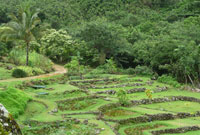
Alison Foster, Oxford Botanic Garden
Medicinal Plant of the Month
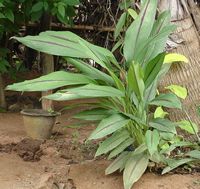
Reports that turmeric may be able to help repair the damage caused after a patient suffers a stroke have been widespread in the media recently. This potential use is just one of many reported for turmeric. Turmeric is a member of the ginger family (photo: Ramesh Raju) and it is the ground up dried rhizome of the plant that we use as an ingredient in curries and other cooking. The magic component of turmeric is curcumin. It has a characteristic yellow colour and is actually used as a food additive. It has an E number (no, they are not all synthetic nasties…..) – E100.
The medicinal properties of curcumin are many and various including neuroprotective, cardioprotective and chemopreventive. There is not enough space here to summarise the vast tracts of work carried out on this molecule so here is just a taster of what's out there!

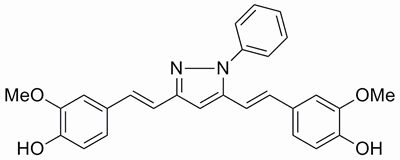
A pyrazole derivative of curcumin, known as CNB-001 has been synthesised and found to be both neuroprotective and memory enhancing. This molecule activates an enzyme known as CaMKII (Calcium/Calmodulin dependent protein kinase II) which plays an important role in the proper functioning of neurons. This could have huge benefits in treating diseases such as Alzheimer's and Parkinson's as well as stroke.
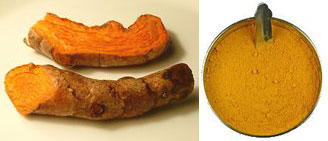
And lastly, I recently met an ethnobotanist who absolutely swears by adding fresh turmeric juice as ear drops whenever he gets an ear infection. I have also been offered hot milk with turmeric added as a cold cure in India. It seems turmeric is good for everything! (photos: left by Badagnani: Turmeric root: right by Sanjay Acharya: Turmeric powder)
Allison Foster, Oxford Botanic Garden
News from our Associates
Commercial Horticultural Association


International Society of Horticultural Science
The Society has started planning for the II International Symposium on Horticulture in Europe - SHE2012, to be held on 1-5 July 2012, in Angers, France. Prof Geoff Dixon will be acting as the UK representative on behalf of the SCI Horticulture Group.

On the 21 February, the Society of Biology moved a few blocks north to its new offices at Charles Darwin House in Roger Street, London. There it joins the Biochemical Society, The British Ecological Society and the Society for Experimental Biology in the building, which is becoming a major centre for the biosciences.
Horticulture Industry News
For the very latest horticultural news follow us on Facebook and or
Twitter.

Sadly Alan Barber, the greatest advocate for public parks and green spaces, has passed away. His death follows a long illness which he bore with characteristic strength, tenacity and remarkable good cheer, still writing and advising and working for the cause right up to within a few days of his eventual passing. Alan Barber fought for many years to reverse the late 20th century decline in public parks. He spent his life in parks: working in them, campaigning for them, and latterly playing in them with his grandchildren. With a combination of practical expertise and reforming zeal, he fought unceasingly for better public understanding of the value of parks, together with dedicated funds for their upkeep. His work has helped to secure the millions of pounds spent on restoring public parks in the past decade.
Weed tree kills superbugs
A University of Missouri researcher has found an antibiotic in the Eastern Red Cedar tree, Juniperus virginiana, that is effective against methicillin-resistant Staphylococcus aureus (MRSA), a 'superbug' that is resistant to most medications. 'I wanted to find a use for a tree species that is considered a nuisance,' said Chung-Ho Lin, research assistant professor in the MU Center for Agroforestry at the College of Agriculture, Food and Natural Resources. 'This discovery could help people fight the bacteria as well as give farmers another cash crop.' (Juniperus virginiana is a source of the anti-cancer drug podophyllotoxin, Alison Foster adds). More
Caterpillars shouldn't take sweets from strangers
Tasty little hairs growing on wild tobacco plants amount to 'evil lollipops' that make caterpillars who eat them more likely to be eaten themselves. Hawkmoth caterpillars (Manduca sexta) readily eat the hairs, reports Ian Baldwin of the Max Planck Institute for Chemical Ecology in Jena, Germany. But consuming them changes the odour of the caterpillars' bodies and excretions making the caterpillars more likely to become lollipops themselves for ants and other predators.
New Centre of Excellence
A Centre of Excellence for UK Farming (CEUKF) aimed at helping the industry meet the increasing challenges in food production and sustainability, is to be established in Cambridge. It will provide a network of expertise to help ensure that the best information and advice on developments in science, innovation and practical know-how are accessible in order to provide real benefits across the supply chain. The two founding institutes are the Institute of Biological, Environmental and Rural Sciences (IBERS) at Aberystwyth University and the National Institute of Agricultural Botany (NIAB), in Cambridge. Supermarket chain Waitrose has agreed to fund the establishment of the centre as part of its commitment to finding long-term solutions to food security, climate change and other issues affecting future agricultural production.
The Biology of Monetary Policy A rose by any other name would smell … like celery?

Clones from seed
The production of exact genetic replicas of important food crops has come a step closer. By combining mutations that abolish the shuffling of genes during sexual reproduction, researchers have found a way to force sexually reproducing plants to clone themselves through seeds. The method, published in Science1, has so far only been tested in the model plant Arabidopsis thaliana, but lead author Raphaël Mercier of the French National Institute for Agricultural Research in Versailles says his lab is working to extend the findings to crops. Such an advance would speed up the time it takes for companies to generate new plant breeds. More
North Carolina State University researchers have inserted a gene from celery into rose plants to help fight off botrytis, or petal blight, one of the rose's major post-harvest diseases. Some fungal pathogens produce a sugar alcohol called mannitol that interferes with the plant's ability to block disease like petal blight. In an effort to make roses live longer, NC State horticultural scientists Dr John Dole and Dr John Williamson lead an effort to insert a gene called mannitol dehydrogenase from celery into roses to 'chew up' mannitol and allow the plant to defend itself from one of its greatest threats. 'This gene is naturally found in many plants, but it's uncertain whether the rose already has it,' Williamson says. 'If it does, it doesn't produce enough enzyme to help the plant fight against petal blight.' More
Invasive plants can be beneficial
A team of Penn State scientists has discovered that human-introduced, invasive species of plants can have positive ecological effects. Tomás Carlo and Jason Gleditsch have studied how invasive fruiting plants affect ecosystems and how those effects, contrary to prevailing ideas, sometimes can be beneficial to an ecological community. The team's research, which will be published in the journal Diversity and Distributions, is expected to affect the way environmental resource managers respond to ecosystem maintenance.
A sustainable alternative to peat?
A patented process to control the degradation of plant material during composting was short-listed as a finalist in the Technical Product category in this year's Grower of the Year awards. The process, invented by Prof Keith Waldron from the Institute of Food Research and developed with the help of industry partners has enabled the production of growing media with sufficient plant structure to provide an alternative to peat. Commercial composting usually destroys plant tissues, leaving an unreliable product for horticulturists. 'The technology developed at IFR has successfully produced a growing medium which closely mimics the properties of peat,' said Dr Steve Carter, Technical Manager at Farplants, a co-operative of five growers.
The key to aphids success
Aphids are some of the most destructive insect pests of crop plants and part of what makes them so effective is the way they can control some of the activities of plants, suppressing their defences and so helping the aphids feed. New research from the John Innes Centre has identified components of the aphid's saliva that manipulate the plants defences. Dr Jorunn Bos, working with Dr Saskia Hogenhout used knowledge gained about the effectors produced by plant pathogens to identify possible effector proteins in the saliva of aphids. They screened thousands of publicly available aphid saliva gland proteins, eventually identifying three which were found to trigger plant defences and/or affect the performance of aphids, suggesting that they may be used by the aphids as effectors.
Is Peruvian expansion sustainable?
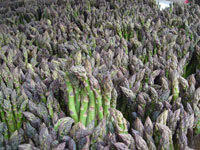
High speed test for seed quality
Scientists from Kew's Millennium Seed Bank and the University of Graz, Austria, have developed a rapid, new method to diagnose seed quality non-invasively and in real time. By using infrared temperature measurement, seed viability results are achieved in less than two hours avoiding time-consuming germination tests, taking up to three days. Conventional tests are also destructive, which is not ideal when assessing the seeds of rare and endangered plants. Infrared cameras are used to detect subtle changes in temperature when seeds take up water; changes which vary with viability. When a dry seed takes up water, the sugar in the seed dissolves and cools the seed down, in peas by as much as 2 to 3°C. Viable seeds continue to maintain cool temperatures because they break down storage reserves into sugar. More
Quotes of the Month
'Suburbia is where the developer bulldozes out the trees, then names the streets after them.'
Events Calendar
Obstacles, risks and opportunities
2 Mar, UK Irrigation Association
Peterborough, UK
Ethnobotany
3 Mar, Oxford Botanic Garden (T: +44(0)1865 286690)
Oxford, UK
Global Conference on Entomology
5- 9 Mar
Chiang Mai, Thailand
The Trentham Estate: A Contemporary Revival
10 Mar, Oxford Botanic Garden
Oxford, UK
Sustainable Vegetable Production in South East Asia
14 - 17 Mar, International Society for Horticultural Science
Salatiga, Indonesia
New Ag International Conference & Exhibition
15 -17 Mar, New Ag International
Cairo, Egypt
Wild Relatives of Subtropical and Temperate Fruit and Nut Crops
19 - 23 Mar, International Society for Horticultural Science
Davis, CA, USA
The Icing on the Cake
24 Mar, Oxford Botanic Garden
Oxford, UK
Forests and Global Change
28 - 30 Mar, British Ecological Society
Cambridge, UK
Organic Matter Management and Compost Use in Horticulture
4 - 7 Apr, International Society for Horticultural Science
Adelaide, Australia
Multitrophic Interactions in Soil
4 - 7 Apr, IOBC / WPRS
Cordoba, Spain
Advances in Cider and Fruit Wine Technology
7 Apr, Association of Applied Biologists
Pershore, UK
Society of Biology AGM
12 Apr, Society of Biology
London, UK
Innovative ideas in pest and weed control in field vegetables
13 Apr, Association of Applied Biologists
Rothamsted, UK
Trees, People and the Built Environment
13 - 14 Apr, Chartered Institute of Foresters
Birmingham, UK
Systems Approaches to Crop Improvement
14 - 15 Apr, Association of Applied Biologists
Rothamsted, UK
Vegetation Management
27 - 28 Apr, Association of Applied Biologists
Sheffield, UK
Microbial Horticulture
15 - 19 May, International Society for Horticultural Science
Alnarp, Sweden
Edible Alliaceae
16 - 19 May, International Society for Horticultural Science
Fukuoka, Japan
Postharvest Unlimited
23 - 26 May, International Society for Horticultural Science
Leavenworth, USA
BIAC AGM
25 May, British Institute of Agricultural Consultants
Tetbury, UK
If you would like to advertise a forthcoming event please contact communications@soci.org
Horticulture Group Contact Details
For submitting ideas or to volunteer to be part of a committee or a group, please contact:
Chairman - Peter Grimbly
Meetings Secretary - Marion Stainton
Minutes Secretary - Margaret Waddy
Newsletter Co-ordinator - Sue Grimbly, E: scihortigroup@btinternet.com
Group Coordinator - Zoe Daniel zoe.daniel@soci.org T: +44 (0)20 7598 1594
